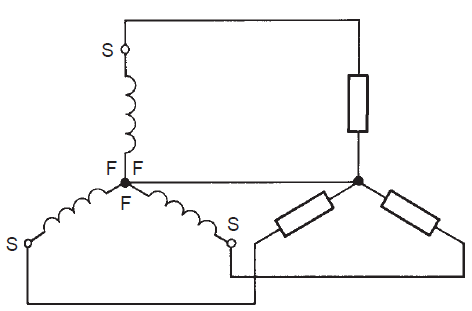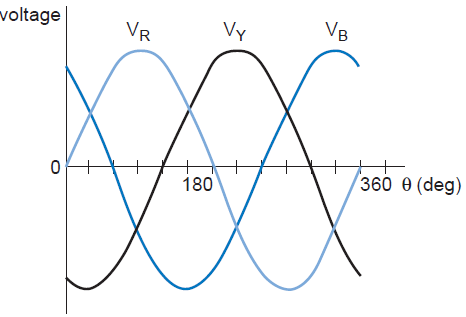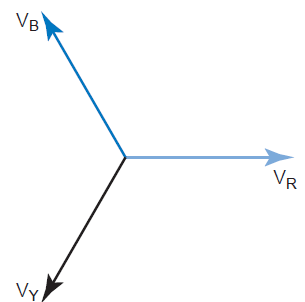Three-phase, Four-wire System
Three-Phase, Four-Wire System: It is not necessary to have six wires from the three phase windings to the three loads, provided there is a common ‘ return ’ line. Each winding will have a ‘ start ’ (S) and a ‘ fi nish ’ (F) end. The common connection mentioned above is achieved by connecting the corresponding ends of the three phases together. For example, either the three ‘ F ’ ends or the three ‘ S ’ ends are commoned. This form of connection is shown in Fig.(given below) , and is known as a star or Y connection. With the resulting 4-wire system, the three loads also are connected in star confi guration.
The three outer wires are called the lines, and the common wire in the centre is called the neutral.

If the three loads were identical in every way (same impedance and phase angle), then the currents fl owing in the three lines would be identical. If the waveform and/or phasor diagrams for these currents were drawn, they would be identical in form to Figs. A and B . These three currents meet at the star point of the load. The resultant current returning down the neutral wire would therefore be zero. The load in this case is known as a balanced load, and the neutral is not strictly necessary. However it is diffi cult, in practice, to ensure that each of the three loads are exactly balanced. For this reason the neutral is left
in place. Also, since it has to carry only the relatively small ‘ out-ofbalance ’ current, it is made half the cross-sectional area of the lines. Let us now consider one of the advantages of this system compared with both a single-phase system, and the three-phase 6-wire system. Suppose that three identical loads are to be supplied with 200 A each. The two lines from a single-phase alternator would have to carry the total 600 A required. If a 3-phase, 6-wire system was used, then each line would have to carry only 200 A. Thus, the conductor csa would only need to be 1/3 that for the single-phase system, but of course, being six lines would entail using the same total amount of conductor material. If a 4-wire, 3-phase system is used there will be a saving on conductor costs in the ratio of 3.5:6 (the 0.5 being due to the neutral). If the power has to be sent over long transmission lines, such as the National Grid System, then the 3-phase, 4-wire system yields an enormous saving in cable costs. This is one of the reasons why the power generating companies use three-phase, star-connected generators to supply the grid system.
 figure A
figure A
 figure B
figure B